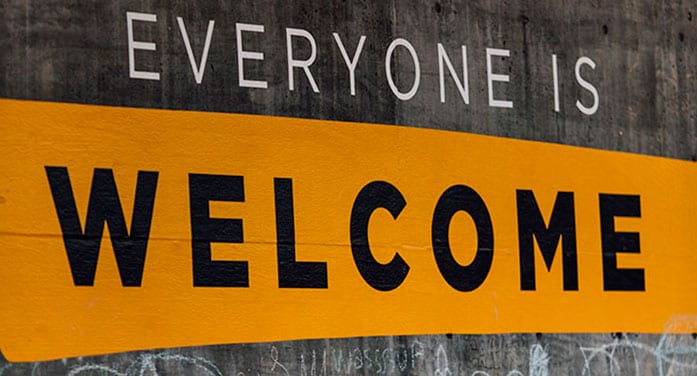
Even when boundaries define arbitrary lines between territories, they embody deeper symbolic, cultural, historical and religious meaning that’s often contested for legitimacy.
Our belief that borders are indisputable has at times led to remarkable efforts to establish permanent barriers as statements of sovereignty and against foreign intrusion.
The Great Wall of China, built for defence against the nomadic tribes of Inner Mongolia, extends more than 6,000 km. The earliest record of the Great Wall dates back to 656 BC and it’s one of the few man-made features recognizable from space.
Built by Emperor Hadrian in AD 122 to defend the northern limits of the Roman Empire, the remains of Hadrian’s Wall can still be seen today across northern England. Hadrian’s Wall and its system of ditches, which run approximately 135 km, formed a physical and ideological barrier between civility and barbarism.
The Berlin Wall, a barbed wire and concrete structure between East and West Berlin, was erected in 1961 by the communist government of the German Democratic Republic to prevent mass defections from the East to the West. This powerful symbol of the Cold War stood until 1989.
In 2002, the government of Israel approved the construction of a 712-km wall around the West Bank to prevent violent attacks.
According to Elisabeth Vallet, a geography professor at the University of Quebec at Montreal, there were seven border walls or fences in the world at the end of the Second World War. That number had grown to 15 by the time the Berlin Wall fell in 1989. By 2018, there were at least 77 walls or fences around the world. Forty-seven border fences were built in the decade following 9/11, 19 in Europe and the Middle East following the aftershocks of the Arab spring and another seven in the Schengen territory of Europe.
Former President Donald Trump’s wall along the southern border of the United States became for many a long-awaited remedy for the unending drift of undocumented and illegal immigration into the country, along with a host of associated criminal activity. It’s also the object of ridicule and embarrassment. The wall was both literal and symbolic of the policies intended to “Make America Great Again.” The wall formed a central tenet of Trump’s platform, and became a lightning rod for divisive and partisan politics, and an increasingly disparate electorate.
The metaphorical impact of borders is possibly even more powerful than as markers of geographical boundaries.
It’s worth noting that Hadrian’s Wall and the Berlin Wall collapsed due to forces within rather than outside.
And China’s success at walling itself off from the outside world couldn’t be sustained. In the end, it couldn’t resist global participation, even though the wall was a metaphor for an inward-looking society.
If preventing human migration is the goal of such walls, surely 1,000 km of hostile open sea, with all its perils, would be just as effective. And yet tens of thousands of refugees have risked everything to cross open water in search of a better life.
Even Australia, separated from Asia by thousands of kilometres of open water, hasn’t been immune from those seeking asylum. Thousands of asylum seekers, from as far away as Afghanistan and Iraq, have risked their lives aboard rickety rafts in hope of making landfall in Australia. And despite some of the world’s harshest policies, the flow of hopeful migrants continues into Australia unabated.
An unending flow of refugees crosses the Mediterranean into Southern Europe. Despite terrible odds, this flow also remains unabated.
And refugees from Cuba and Haiti continue to brave their way across the shark-infested waters that separate them from the east coast of Florida.
This isn’t to suggest that borders aren’t essential or that restrictions shouldn’t be enforced. But borders and barriers can at best only provide temporary solutions to the larger challenge of displaced peoples.
Here are some figures from the United Nations High Commission on Refugees (UNHCR) that provide context:
- one per cent of the world’s population is displaced;
- 80 per cent of the world’s displaced populations are in territories or countries affected by acute food insecurity and malnutrition;
- 40 per cent of the world’s displaced people are children;
- 85 per cent of the world’s displaced people are hosted in developing countries;
- there are approximately 4.2 million stateless people;
- millions of stateless people have been denied a nationality and lack access to basic rights such as education, health care, employment and freedom of movement;
- among the forcibly displaced, there are 25.9 million refugees, 41.3 million people displaced in their own countries and 3.5 million asylum-seekers awaiting determination on refugee status;
- more than half of the world’s 25.9 million refugees are under 18;
- an estimated 25 per cent of internally displaced peoples are young women, with pregnant women making up another four per cent;
- one person is forcibly displaced approximately every two seconds.
The challenges faced at the southern border of the United States are enormous. According to the UNHCR, over five million Venezuelans now live abroad, the vast majority in countries in Latin America and the Caribbean. This has become one of the largest displacement crises in the world.
The UNHCR reports that between 2014 and 2019, Venezuelans lodged close to 800,000 asylum claims globally – 75 per cent in 2018 and 2019. Approximately 2.4 million residency permits and stay visas have been granted to Venezuelans, allowing them to remain in host countries, and access basic rights and services.
Growing numbers of people are leaving Venezuela due to the deteriorating political, human rights and socio-economic conditions. They seek to escape violence, insecurity and hunger, as well as lack of medicine and essential services. Migrants are scared, tired and in dire need of assistance.
Human trafficking is ranked as the fastest-growing criminal enterprise in the world, competing with the illicit arms trade as the second-largest criminal industry after drug trafficking. The connection between migration and human trafficking is particularly visible in Mexico and its neighbouring countries. The corridor through Mexico is one of the most used mixed migration routes in the world, with the U.S.-Mexico border being the most crossed border worldwide.
Annually, hundreds of thousands of irregular migrants pass through Mexico determined to get to the United States. Many use smugglers to help them get there. It’s not uncommon for these agreements to evolve into trafficking.
In addition, migrants in Mexico run a great risk of being kidnapped and trafficked. Migrants also travel for jobs, which simply turn out to be exploitative or of a different nature than what was first agreed upon.
According to the Migration Policy Institute (MPI), Mexicans in the U.S. accounted for 51 per cent of the 11 million unauthorized immigrants in 2018.
To aggravate matters, the UN estimates that some 10 million to 13 million Latin Americans live in another country in the region, double the number from 2000.
According to the U.S. Department of Homeland Security, 29,916 persons were admitted to the United States as refugees during 2019. The leading countries of nationality were the Democratic Republic of the Congo (Congo), Myanmar, and Ukraine. And 46,508 individuals were granted asylum during 2019. The leading countries of nationality for persons granted asylum were the People’s Republic of China (China), Venezuela and El Salvador.
This looming humanitarian crisis is unlikely to be kept at bay.
The current state of human migrations isn’t new. And while it ought to be part of ongoing considerations for policy-makers and politics, it has become ripe for over-politicization based on public perception that nations have lost control of their borders, compounding fears of cultural erosion, and exacerbating anti-immigrant and anti-refugee sentiments.
Anti-immigrant movements frequently object to what they see as foreigners competing for jobs and drawing on the welfare state at the expense of the native-born population. They attribute crime to immigrants and see them as representing threats to traditional norms, practices, and to the existing political and economic power structures.
An alternative view of borders and barriers ought also to be considered. There are many largely undefended borders, like the one between Canada and the United States, which have not required fences and barriers.
People leave their prevailing conditions when their survival is imperilled, or the conditions under which they live become so unbearable that they’re willing to risk leaving for better prospects.
There are two solutions to the challenge of human migrations.
The first is to create barriers, close borders, and place guards and technology to deter crossings. This choice has significant monetary and moral consequences.
The second is more complicated and challenging, but it’s a long-term solution, unlike the first. It involves attempting to help societies from which people are fleeing to improve their social conditions and to encourage governments to recognize and live up to the social contract they have with their citizens.
The problem is that there are two competing views on how to achieve the second solution. The first has been the free-market approach, based on supply and demand, deregulation of government control and privatization of markets. The second would require governments to undertake land reform and social programs for health, education, and welfare – what free-market advocates would too generally label as socialism.
There is no way out of the current global humanitarian crisis other than by holding developing and emerging economies responsible for their citizens’ welfare, and where necessary promoting deregulation and globalization.
All foreign aid, trade and defence agreements should require recipients to achieve social programs that improve the conditions of the millions of neglected and desperate citizens. This necessitates a partnership between free-market capitalism and developmental socialism.
Few asylum seekers flee the shores of Cambodia and Vietnam today, and far fewer refugees flee Ethiopia and India than in the past. These countries make the risk of leaving greater than the benefits of remaining.
It’s the same reason Canadians don’t rush south of the border. There’s just too much that this country offers, even if at times the opportunities appear better south of the border.
Anil Anand is a research associate with the Frontier Centre for Public Policy.
Anil is one of our Thought Leaders. For interview requests, click here.
The views, opinions and positions expressed by columnists and contributors are the authors’ alone. They do not inherently or expressly reflect the views, opinions and/or positions of our publication.


